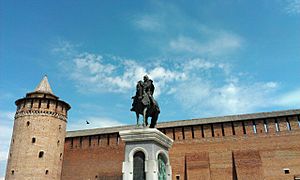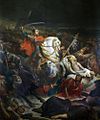Dmitry Donskoy facts for kids
Quick facts for kids Dmitry of the Don |
|||||
|---|---|---|---|---|---|
 |
|||||
| Grand Prince of Moscow | |||||
| Reign | 13 November 1359 – 19 May 1389 | ||||
| Predecessor | Ivan II | ||||
| Successor | Vasiliy I | ||||
| Born | 12 October 1350 Moscow, Grand Duchy of Moscow |
||||
| Died | 19 May 1389 (aged 38) Moscow, Grand Duchy of Moscow |
||||
| Burial | Cathedral of the Archangel, Moscow Kremlin | ||||
| Consort | Eudoxia Dmitriyevna | ||||
| Issue more... |
Vasily Dmitriyevich Yury Dmitriyevich |
||||
|
|||||
| Dynasty | Rurik | ||||
| Father | Ivan II of Moscow | ||||
| Mother | Alexandra Vasilyevna Velyaminova | ||||
Dmitry Ivanovich Donskoy (born October 12, 1350 – died May 19, 1389) was a very important leader in Russian history. He was the Prince of Moscow from 1359 and the Grand Prince of Vladimir from 1363 until his death. He was the first Russian prince to bravely challenge the power of the Mongol invaders.
Dmitry earned his famous nickname, Donskoy, which means "of the Don". This name came from his great victory against the Tatars (a group of Mongols) in the Battle of Kulikovo in 1380. This battle took place near the Don River. Dmitry is honored as a Saint in the Orthodox Church. His special day is May 19.
Contents
Becoming a Leader: Dmitry's Early Reign
Dmitry was born in Moscow in 1350. His father was Ivan the Fair, who was the Grand Prince of Moscow. Dmitry's mother was Alexandra Vassilievna Velyaminova. Sadly, Dmitry's father died when Dmitry was only nine years old. This meant Dmitry became the Prince of Moscow at a very young age.
Because he was so young, a wise church leader named Metropolitan Aleksey helped rule Moscow as a regent. A regent is someone who governs for a young king or prince until they are old enough to rule themselves.
In 1360, the Golden Horde (the Mongol rulers) gave the important title of Grand Prince of Vladimir to another prince, Dmitri Konstantinovich of Nizhniy Novgorod. But in 1363, Dmitry Ivanovich was crowned at Vladimir. Three years later, he made peace with Dmitry Konstantinovich and married his daughter, Eudoxia Dmitriyevna.
One of the most important things Dmitry did early in his rule was to start building the Moscow Kremlin. This strong fortress was finished in 1367. Thanks to the new Kremlin, Moscow was able to defend itself from two attacks by Algirdas of Lithuania. These attacks happened during the Lithuanian–Muscovite War (1368–72). The war ended with a peace agreement called the Treaty of Lyubutsk.
By 1375, Dmitry had also settled a disagreement with Mikhail II of Tver over who would rule Vladimir. Other princes in Northern Russia agreed to follow Dmitry's lead. They even sent their soldiers to help him fight against the Golden Horde. By the end of his rule, Dmitry had made the Principality of Moscow more than twice as big.
Fighting for Freedom: The Struggle Against Mamai
During Dmitry's 30-year rule, the power of the Mongol rulers in Russia began to weaken. The Golden Horde was having many problems, including civil wars and fights over who should be the next leader. Dmitry saw this as a chance to openly challenge the Tatars.
Dmitry was known for leading the first big Russian military victory over the Mongols. In 1378, a Mongol general named Mamai sent an army to punish Dmitry. But Dmitry's forces defeated them in the Battle of Vozha River.
Two years later, Mamai himself led a very large army against Moscow. Before the battle, a respected monk named Sergius of Radonezh gave Dmitry Donskoy his blessing. Sergius sent two warrior monks, Alexander Peresvet and Rodion Oslyabya, to join the Russian army.
The Battle of Kulikovo began with a special fight between two champions. The Russian champion was Alexander Peresvet. The Mongol champion was Temir-murza. Both champions died in their first clash. After this, Dmitry led his army to defeat the Golden Horde. To thank God for this victory, Dmitry built a monastery and a church.
After this defeat, Mamai was overthrown by another Mongol general, Tokhtamysh. This new leader took back control of Russia and attacked Moscow in 1382. Dmitry then promised to be loyal to Tokhtamysh and the Golden Horde. He was allowed to continue as the main tax collector and Grand Duke of Vladimir.
When Dmitry died in Moscow in 1389, he did something new. He was the first Grand Duke to pass his titles directly to his son, Vasili I, without asking the Mongol Khan for permission. This was a big step towards Russia's independence.
Dmitry's Family: Marriage and Children

Dmitry Donskoy was married to Eudoxia of Nizhniy Novgorod. She was the daughter of Dmitry of Suzdal. Dmitry and Eudoxia had at least twelve children together:
- Daniil Dmitriyevich (born around 1370 – died 1379)
- Vasiliy I of Moscow (born 1371 – died 1425)
- Sofia Dmitriyevna. She married Fyodor Olegovich, who was the Prince of Ryazan.
- Yuriy Dmitriyevich, Duke of Zvenigorod and Galich (born 1374 – died 1434). He later tried to become the ruler of Moscow.
- Maria Dmitriyevna (died 1399). She married Lengvenis.
- Anastasia Dmitriyevna. She married Ivan Vsevolodovich, Prince of Kholm.
- Simeon Dmitrievich (died 1379)
- Ivan Dmitriyevich (died 1393)
- Andrey Dmitriyevich, Prince of Mozhaysk (born 1382 – died 1432)
- Pyotr Dmitriyevich, Prince of Dmitrov (born 1385 – died 1428)
- Anna Dmitriyevna (born 1387). She married Yury Patrikiyevich.
- Konstantin Dmitriyevich, Prince of Pskov (born 1389 – died 1433)
Gallery
-
Dmitriy Donskoy in the Battle of Kulikovo, painted by Adolphe Yvon.
Images for kids
-
Dmitriy Donskoy on the Millennium of Russia monument in Veliky Novgorod.
See also
 In Spanish: Dmitri Donskói para niños
In Spanish: Dmitri Donskói para niños





